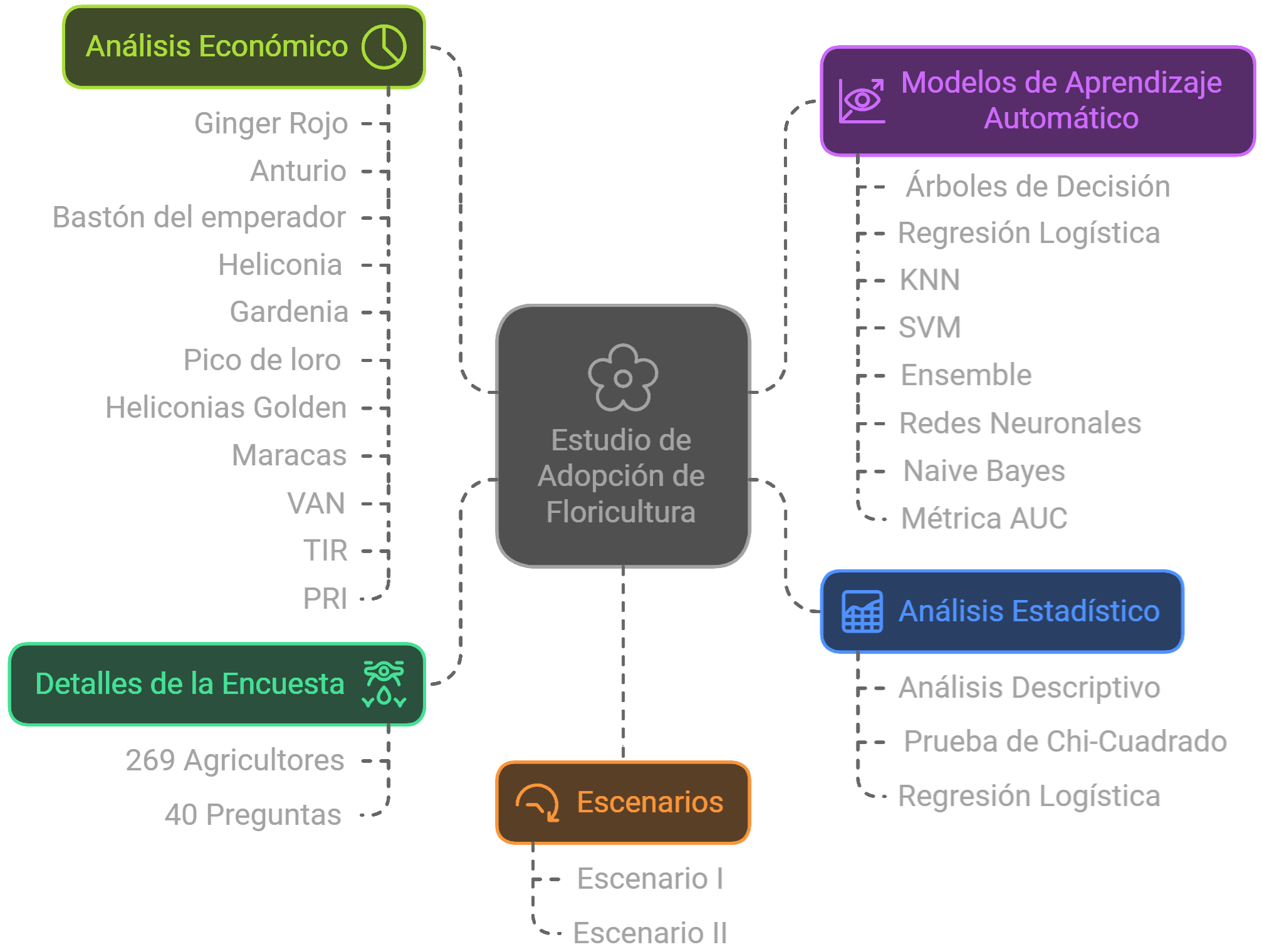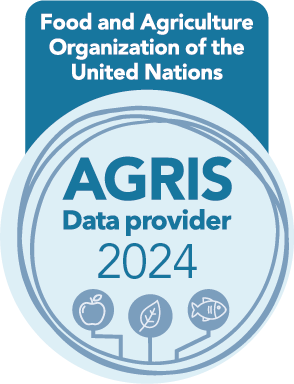La floricultura como cultivo alternativo: Análisis descriptivo, modelación con inteligencia artificial, análisis de escenarios y análisis económico
DOI:
https://doi.org/10.17268/sci.agropecu.2025.003Palabras clave:
Floricultura, análisis económico, cultivo alternativo, inteligencia artificial, biodiversidad, sostenibilidad, comercio justoResumen
La floricultura es un sector de creciente importancia a nivel mundial, contribuyendo a la generación de empleo, ingresos y a la promoción de la biodiversidad y la sostenibilidad. Este estudio tuvo como objetivo identificar los factores que influyen en la adopción de la floricultura como cultivo alternativo en la provincia de Leoncio Prado, Perú, y evaluar su viabilidad económica. Para ello, se encuestó a 269 agricultores, analizando actitudes, aptitud de la tierra, factores socioeconómicos y ambientales. Mediante análisis descriptivo, pruebas de chi-cuadrado y regresión logística (p < 0,1) se seleccionaron los factores influyentes. Además, se emplearon múltiples algoritmos de aprendizaje automático (Árboles de Decisión, Regresión Logística, KNN, SVM, Ensemble, Redes Neuronales, Naive Bayes) con validación cruzada (k = 5) y métricas AUC para modelar la intención de adopción. Se desarrollaron escenarios incrementando la predisposición a adoptar la floricultura, y se realizó un análisis económico de ocho especies tropicales (Ginger Rojo, Anturio, Bastón del Emperador, Heliconia, Gardenia, Pico de Loro, Heliconias Golden, Maracas). Los resultados revelan que la disposición a cambiar de cultivo, la participación en campañas de sensibilización, la destinación de áreas a la conservación y el control de costos son factores clave. El modelo de redes neuronales alcanzó un AUC de 83,3% y escenarios mejorados indican que la adopción podría incrementar hasta en 11,32%. El Ginger Rojo demostró alta rentabilidad (VAN S/10428; TIR 51%; PRI 0,7 años). En conclusión, la floricultura representa una alternativa económica y ambientalmente viable que contribuye a la diversificación agrícola y a la sostenibilidad.
Citas
Afonso, M., Paulo, M.-J., Fonteijn, H., van den Helder, M., Zwinkels, H., Rijsbergen, M., et al. (2024). Automatic trait estimation in floriculture using computer vision and deep learning. Smart Agricultural Technology, 7. https://doi.org/10.1016/j.atech.2023.100383
Alavi-Murillo, G., Diels, J., Gilles, J., & Willems, P. (2022). Soil organic carbon in Andean high-mountain ecosystems: importance, challenges, and opportunities for carbon sequestration. Regional Environmental Change, 22(4), 128. https://doi.org/10.1007/s10113-022-01980-6
Blare, T., & Donovan, J. (2018). Building value chains for indigenous fruits: lessons from camu-camu in Peru. Renewable Agriculture and Food Systems, 33(1), 6–18. https://doi.org/10.1017/S1742170516000181
Chabalala, Y., Adam, E., & Ali, K. A. (2023). Exploring the Effect of Balanced and Imbalanced Multi-Class Distribution Data and Sampling Techniques on Fruit-Tree Crop Classification Using Different Machine Learning Classifiers. Geomatics 2023, Vol. 3, Pages 70-92, 3(1), 70–92. https://doi.org/10.3390/GEOMATICS3010004
De Pascale, S., & Romano, D. (2019). Potential use of wild plants in floriculture. Acta Horticulturae, 1240, 87–98. https://doi.org/10.17660/ACTAHORTIC.2019.1240.15
Devaux, A., Torero, M., Donovan, J., & Horton, D. (2018). Agricultural innovation and inclusive value-chain development: a review. Journal of Agribusiness in Developing and Emerging Economies, 8(1), 99–123. https://doi.org/10.1108/JADEE-06-2017-0065
Ellis, R. E. (2016). The Evolving Transnational Crime-Terrorism Nexus in Peru and its Strategic Relevance for the U.S. and the Region. PRISM, 5(4), 188–205. http://www.jstor.org/stable/26459220
Eyhorn, F., Muller, A., Reganold, J. P., Frison, E., Herren, H. R., Luttikholt, L., et al. (2019). Sustainability in global agriculture driven by organic farming. Nature Sustainability, 2(4), 253–255. https://doi.org/10.1038/s41893-019-0266-6
Farooqui, N. A., & Ritika. (2020). A Machine Learning Approach to Simulating Farmers’ Crop Choices for Drought Prone Areas. Lecture Notes in Electrical Engineering, 605, 472–481. https://doi.org/10.1007/978-3-030-30577-2_41
Garcia-Yi, J. (2014). Heterogeneous motivations for coca growing: The case of an indigenous Aymara community in Peru. International Journal of Drug Policy, 25(6), 1113–1123. https://doi.org/10.1016/J.DRUGPO.2014.05.011
Gomiero, T., Pimentel, D., & Paoletti, M. G. (2011). Is There a Need for a More Sustainable Agriculture? Critical Reviews in Plant Sciences, 30(1–2), 6–23. https://doi.org/10.1080/07352689.2011.553515
Graskemper, V., Yu, X., & Feil, J. H. (2021). Farmer typology and implications for policy design – An unsupervised machine learning approach. Land Use Policy, 103, 105328. https://doi.org/10.1016/J.LANDUSEPOL.2021.105328
Hall, T. J., Dennis, J. H., Lopez, R. G., & Marshall, M. I. (2009). Factors Affecting Growers’ Willingness to Adopt Sustainable Floriculture Practices. HortScience, 44(5), 1346–1351. https://doi.org/10.21273/HORTSCI.44.5.1346
Jezeer, R. E., Verweij, P. A., Boot, R. G. A., Junginger, M., & Santos, M. J. (2019). Influence of livelihood assets, experienced shocks and perceived risks on smallholder coffee farming practices in Peru. Journal of Environmental Management, 242, 496–506. https://doi.org/10.1016/J.JENVMAN.2019.04.101
Jula, G., Kim, D.-G., & Nigatu, S. (2024). Potential of floriculture waste-derived charcoal briquettes as an alternative energy source and means of mitigating indoor air pollution in Ethiopia. Energy for Sustainable Development, 79. https://doi.org/10.1016/j.esd.2024.101390
Junqueira, A. H., & Peetz, M. da S. (2018). Sustainability in Brazilian floriculture: introductory notes to a systemic approach. Ornamental Horticulture, 24(2), 155–162. https://doi.org/10.14295/OH.V24I2.1253
Kremen, C., Williams, N. M., Aizen, M. A., Gemmill-Herren, B., LeBuhn, G., Minckley, R., et al. (2007). Pollination and other ecosystem services produced by mobile organisms: a conceptual framework for the effects of land-use change. Ecology Letters, 10(4), 299–314. https://doi.org/https://doi.org/10.1111/j.1461-0248.2007.01018.x
Li, Y., & Dong, X. (2023). A RUSBoosted tree method for k-complex detection using tunable Q-factor wavelet transform and multi-domain feature extraction. Frontiers in Neuroscience, 17, 1108059. https://doi.org/10.3389/FNINS.2023.1108059
Manikas, I., Malindretos, G., & Abeliotis, K. (2020). Sustainable Cities through Alternative Urban Farming: The Case of Floriculture. Journal of International Food & Agribusiness Marketing, 32(3), 295–311. https://doi.org/10.1080/08974438.2019.1599762
Morales, E. (1986). Coca and Cocaine Economy and Social Change in the Andes of Peru. Economic Development and Cultural Change, 35(1), 143–161. https://doi.org/10.1086/451575
Phondani, P. C., Bhatt, I. D., Maikhuri, R. K., Kothyari, B. P., Bhatt, A., Purohit, V. K., & Joshi, P. (2019). Exploring Floriculture Potential for Sustainable Livelihood of Subsistence Communities in Indian Himalaya. National Academy Science Letters, 42(1), 39–44. https://doi.org/10.1007/S40009-018-0660-Z
Romero, D. B. C., Estrella, Y. G. M., Laureano, M. I. Z., Parejas, R. Á. R., & Quispe, J. A. D. (2022). A machine learning approach to find the determinants of Peruvian coca illegal crops. Decision Science Letters, 11(2), 127–136. https://doi.org/10.5267/J.DSL.2021.12.003
Sahu, D., Sahu, J. K., Kumar, V., & Gupta, P. (2023). Role of Floriculture in Promoting Biodiversity and Enhancing Ecosystems: A Comprehensive Review. International Journal of Environment and Climate Change, 13(9), 2077–2084. https://doi.org/10.9734/IJECC/2023/V13I92439
Schelleman-Offermans, K., Dito, B. B., Gudeta, K. H., Fourie, E., Kebede, S. W., Mazzucato, V., & Jonas, K. J. (2024). Socio-economic inequities in mental health problems and wellbeing among women working in the apparel and floriculture sectors: testing the mediating role of psychological capital, social support and tangible assets. BMC Public Health, 24(1157). https://doi.org/10.1186/s12889-024-18678-5
Schumacher, S. K., & Marsh, T. L. (2003). Economies of Scale in the Floriculture Industry. Journal of Agricultural and Applied Economics, 35(3), 497–507. https://doi.org/10.1017/S1074070800028236
Tobin, D., Bates, R., Brennan, M., & Gill, T. (2018). Peru potato potential: Biodiversity conservation and value chain development. Renewable Agriculture and Food Systems, 33(1), 19–32. https://doi.org/10.1017/S1742170516000284
Tobin, D., & Glenna, L. (2019). Value Chain Development and the Agrarian Question: Actor Perspectives on Native Potato Production in the Highlands of Peru. Rural Sociology, 84(3), 541–568. https://doi.org/10.1111/RUSO.12251
van Dun, M. (2019). Narco-Territoriality and Shadow Powers in a Peruvian Cocaine Frontier. Terrorism and Political Violence, 31(5), 1026–1048. https://doi.org/10.1080/09546553.2017.1309392
Wani, M. A., Nazki, I. T., Din, A., Iqbal, S., Wani, S. A., Khan, F. U., & Neelofar. (2018). Floriculture Sustainability Initiative: The Dawn of New Era. In E. Lichtfouse (Ed.), Sustainable Agriculture Reviews 27 (pp. 91–127). Springer International Publishing. https://doi.org/10.1007/978-3-319-75190-0_4

Publicado
Cómo citar
Número
Sección
Licencia
Derechos de autor 2025 Scientia Agropecuaria

Esta obra está bajo una licencia internacional Creative Commons Atribución-NoComercial 4.0.
Los autores que publican en esta revista aceptan los siguientes términos:
a. Los autores conservan los derechos de autor y conceden a la revista el derecho publicación, simultáneamente licenciada bajo una licencia de Creative Commons que permite a otros compartir el trabajo, pero citando la publicación inicial en esta revista.
b. Los autores pueden celebrar acuerdos contractuales adicionales separados para la distribución no exclusiva de la versión publicada de la obra de la revista (por ejemplo, publicarla en un repositorio institucional o publicarla en un libro), pero citando la publicación inicial en esta revista.
c. Se permite y anima a los autores a publicar su trabajo en línea (por ejemplo, en repositorios institucionales o en su sitio web) antes y durante el proceso de presentación, ya que puede conducir a intercambios productivos, así como una mayor citación del trabajo publicado (ver efecto del acceso abierto).




